1996 PONTIAC PONTIAC wheel
[x] Cancel search: wheelPage 180 of 370
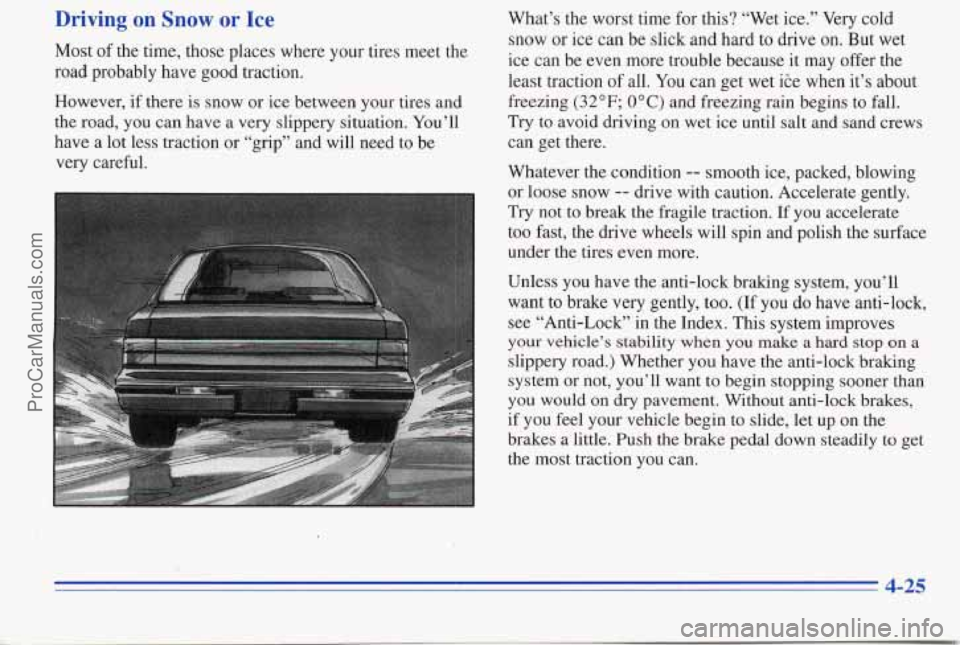
Driving on Snow or Ice
Most of the time, those places where your tires meet the
road probably have good traction. What’s the worst time for
this? “Wet ice.” Very cold
snow or ice can be slick and hard to drive on. But wet
ice can be even more trouble because it may offer the
least traction
of all. You can get wet iCe when it’s about
However, if there
is snow or ice between your tires and freezing (32 OF; OOC) and freezing rain begins to fall.
the road, you can have a very slippery situation. You’ll
Try to avoid driving on wet ice until salt and sand crews
have a lot less traction or “grip” and will need to be can get there.
very careful. Whatever the condition
-- smooth ice, packed, blowing
or loose snow
-- drive with caution. Accelerate gently.
Try not to break the fragile traction. If you accelerate
too fast, the drive wheels will spin and polish the surface
under the tires even more.
Unless you have the anti-lock braking system, you’ll
want to brake very gently, too.
(If you do have anti-lock,
see “Anti-Lock” in the Index. This system improves
your vehicle’s stability when you make a hard stop on a
slippery road.) Whether you have the anti-lock braking
system
or not, you’ll want to begin stopping sooner than
you would on dry pavement. Without anti-lock brakes,
if you feel your vehicle begin to slide, let up on the
brakes a little. Push the brake pedal down steadily
to get
the most traction you can.
ProCarManuals.com
Page 181 of 370
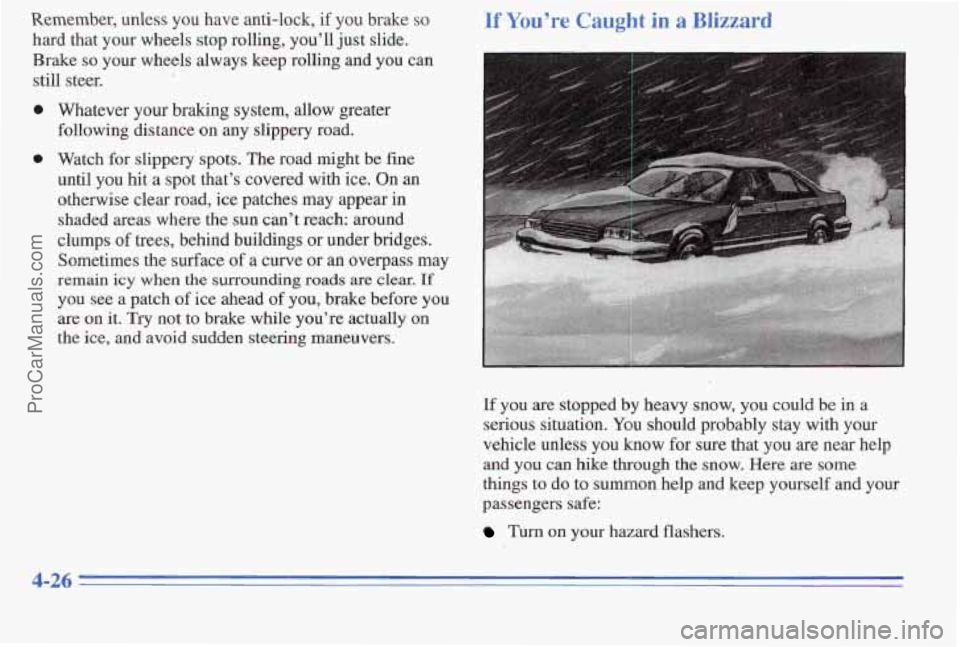
Remember, unless you have anti-lock, if you brake so
hard that your wheels stop rolling, you’ll just slide.
Brake
so your wheels always keep rolling and you can
still steer.
0 Whatever your braking system, allow greater
following distance on
any slippery road.
0 Watch for slippery spots. The road might be fine
until you hit a spot that’s covered with ice. On
an
otherwise clear road, ice patches may appear in
shaded areas where the
sun can’t reach: around
clumps
of trees, behind buildings or under bridges.
Sometimes the surface of a curve or an overpass may
remain icy when the surrounding roads are clear. If
you see a patch of ice ahead of you, brake before you
are on it. Try not to brake while you’re actually on
the ice, and avoid sudden steering maneuvers.
If You’re Caught in a Blizzard
If you are stopped by heavy snow, you could be in a
serious situation. You should probably stay with your
vehicle
unless you know for sure that you are near help
and
you can hike bough the mow. Here are some
things to do to summon help and keep yourself and your
passengers safe:
Ttim on your hazaid flashers.
4-26
ProCarManuals.com
Page 186 of 370

four vehicle can tow a trailer. To identify what the
vehicle trailering capacity is for your vehicle, you
should read the information
in “Weight of the Trailer”
that appears later in this section. But trailering is
different than just driving your vehicle by itself.
Trailering means changes in handling, durability, and
fwl economy. Successful, safe trailering takes correct
equipment, and
it has to be used properly.
That’s the reason for this part. In it are many
time-tested, important trailering tips and safety rules.
Many of these are important for your safety and that
of
your passengers. So please read this section carefully
before you pull
a trailer.
Load-pulling components such as the engine, transaxle,
wheel assemblies and tires are forced to work harder
against the drag
of the added weight. The engine is
required to operate at relatively higher speeds and under
greater loads, generating extra heat. What’s more, the
trailer adds considerably to wind resistance, increasing
the pulling requirements.
If You Do Decide To Pull A Trailer
If you do, here are some important points:
0
0
0
0
0
There are many different laws, including speed limit
restrictions, having
to do with trailering. Make sure
your rig will be legal, not only where you live but
also where you’ll be driving.
A good source fa this
information can be state or provincial police.
Consider using
a sway control. You can ask a hitch
dealer about sway controls.
Don’t tow a trailer
at all during the first 1,000 miles
(1 600 km) your new vehicle is driven. Your engine,
axle
or other parts could be damaged.
Then, during the
fkst 500 miles (800 km) that you tow
a trailer, don’t drive
over 50 mph (80 km/h) and don’t
make starts at
full throttle. This helps your engine and
other parts
of your vehicle wear in at the heavier loads.
Obey speed limit restrictions when towing a trailer.
Don’t drive faster than the maximum posted speed
for trailers (or no more than
55 mph (90 km/h)) to
save wear on your vehicle’s parts.
Three important considerations have to do with weight:
the weight of the trailer,
0 the weight of the trailer tongue
0 and the total weight on your vehicle’s tires.
4-31
ProCarManuals.com
Page 190 of 370
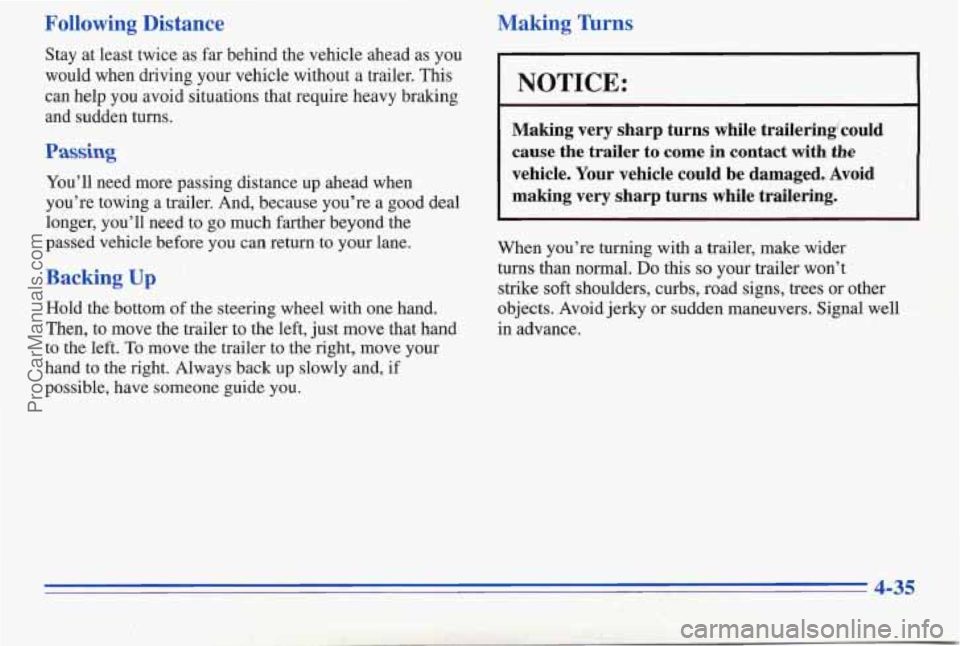
Following Distance
Stay at least twice as far behind the vehicle ahead as you
would when driving your vehicle without
a trailer. This
can help you avoid situations that require heavy braking
and sudden turns.
Passing
You'll need more passing distance up ahead when
you're towing a trailer. And, because you're a good deal
longer, you'll need to go much farther beyond the
passed vehicle before you can return .to your lane.
Backing Up L
- i -. ,. .. ,.
-'l, '' I. . '.:', .i Hold the bottom of the steering wheel with one hand.
' ' Then, to move the trailer to the left, just move that hand
to the left. To move the trailer to the right, move your
hand to the right. Always 'back up slowly and,
if
possible, have someone guide you.
Making 'hms
I
I NOTICE:
Making very sharp turns while trailering'could
cause the trailer to come
in contact with the
vehicle. Your vehicle could be damaged. Avoid
making very sharp turns while trailering.
When you're turning with a trailer, make wider
. . turns than normal. Do this so your trailer won't
strike soft shoulders, curbs, road signs, trees or other
objects. Avoid jerky or sudden maneuvers. Signal well
in advance.
ProCarManuals.com
Page 192 of 370
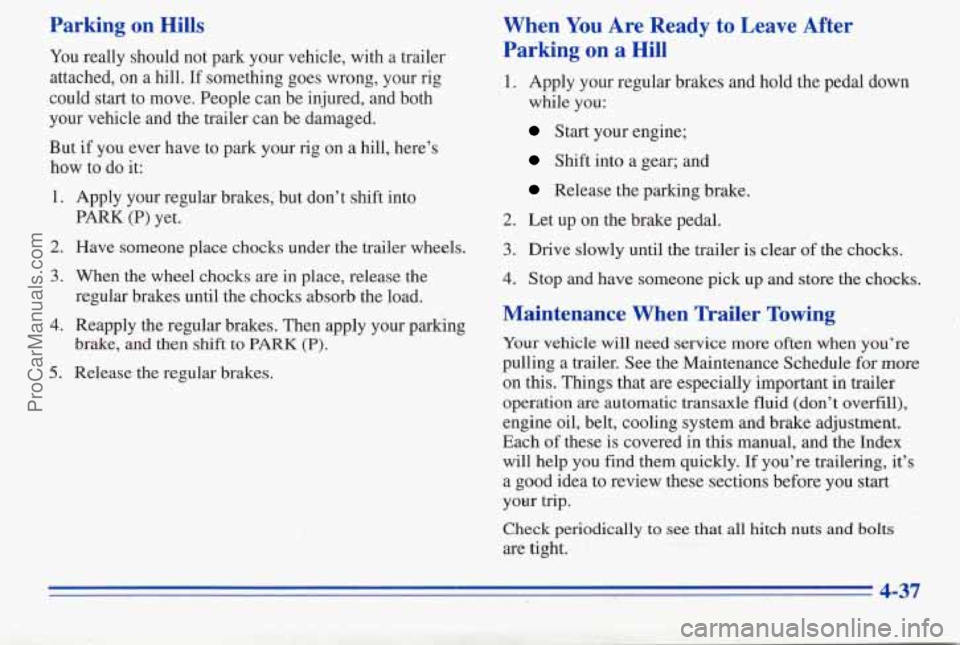
Parking on Hills
You really should not park your vehicle, with a trailer
attached, on
a hill. If something goes wrong, your rig
could
start to move. People can be injured, and both
your vehicle and the trailer can be damaged.
But if you ever have to park your rig on a hill, here’s
how to do it:
1.
2.
3.
4.
5.
Apply your regular brakes, but don’t shift into
PARK (P) yet.
Have someone place chocks under
the trailer wheels.
When the wheel chocks are in place, release the
regular brakes until the chocks absorb the load.
Reapply the regular brakes. Then apply your parking
brake,
and then shift to PARK (P).
Release the regular brakes.
When You Are Ready to Leave After
Parking on a Hill
1. Apply your regular brakes and hold the pedal down
while you:
Start your engine;
Shift into a gear; and
Release the parking brake.
2. Let up on the brake pedal.
3. Drive slowly until the trailer is clear of the chocks.
4. Stop and have someone pick up and store the chocks.
Maintenance When Trailer Towing
Your vehicle will need service more oken when you’re
pulling a trailer. See the Maintenance Schedule for -more
on this. Things that are especially important in trailer
operation
are automatic transaxle fluid (don’t overfill),
engine oil, belt, cooling system and brake adjustment.
Each
of these is covered in this manual, and the Index
will help you find them quickly. If you’re trailering, it’s
a good idea to review these sections before you start
your trip.
Check periodically to see that all hitch nuts and bolts
are tight. ’
4-37
ProCarManuals.com
Page 200 of 370
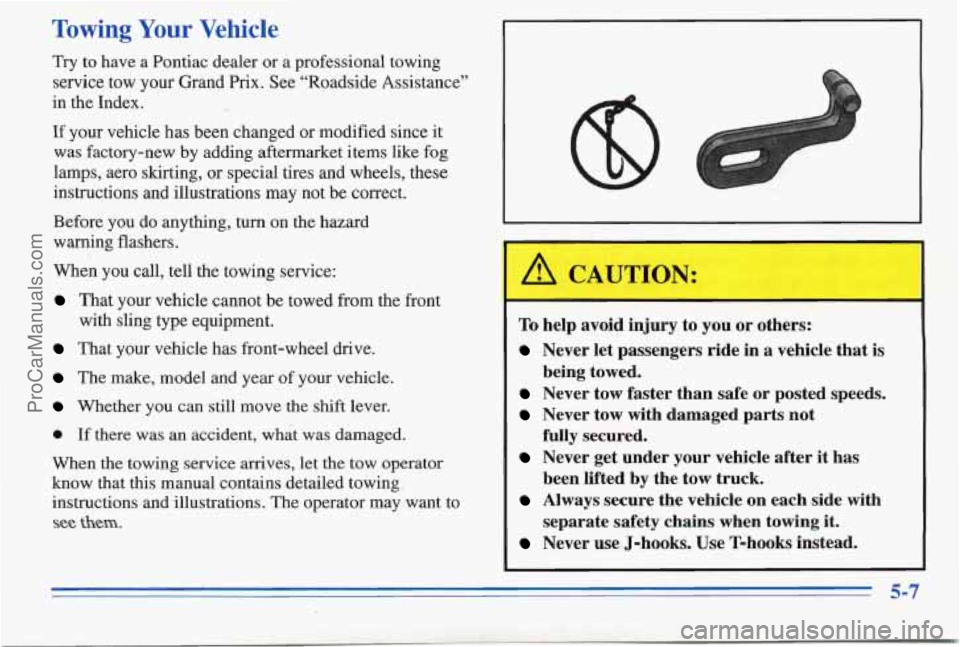
Towing Your Vehicle
Try to have a Pontiac dealer or a professional towing
service tow your Grand
Prix. See “Roadside Assistance”
in the- Index.
If your vehicle has been changed or modified since it
was factory-new by adding aftermarket items like
fog
lamps, aero skirting, or special tires and wheels, these
instructions and illustrations may not be correct.
Before you do anything, turn on the hazard
warning flashers.
When you call, tell the towing service:
That your vehicle cannot be towed from the front
That your vehicle has front-wheel drive.
The make, model and year of your vehicle.
Whether you can still move the shift lever.
0 If there was an accident, what was damaged.
When the towing service arrives, let the tow operator
know that this manual contains detailed towing,
instructions and illustrations. The operator may want to
see t.
with sling type equipment.
I I
I
To help avoid injury to you or others:
Never let passengers ride in a vehicle that is
Never tow faster than safe or posted speeds.
Never tow with damaged parts not
fully secured.
Never get under your vehicle after it has
been lifted by the tow truck.
Always secure the vehicle on each side with
separate safety chains when towing
it.
Never use J-hooks. Use T-hooks instead.
being towed.
‘I
ProCarManuals.com
Page 201 of 370

/r\, CAUTION:
A vehicle can fall from a car carrier if it isn’t
adequately secured. This can cause
a collision,
serio’us personal injury and vehicle damage. The
vehicle should be tightly secured with chains or
steel cables before it
is trapported.
Don’t
use substitutes (ropes, leather straps,
canvas webbing, etc.)
that can be cut by sharp
edges underneath the towed vehicle. Always use
T-hooks inserted in the T-hook slots. Never use
J-hooks. They will damage drivetrain and
suspension components.
~~
When your vehicle is being towed, have the ignition
turned
to the OFF position. The steering wheel should
be clamped in a straight-ahead position, with a
clamping device designed
for towing service. Do not
use the vehicle’s steering column lock for ths The
transaxle should be
in NEUTRAL (N) and the
parking brake released.
Don’t have your vehicle towed on the drive wheels,
unless you must. If the vehicle must be towed on the
drive wheels, be
sure to follow the speed and distance
restrictions later in this section or
your transaxle will be
damaged.
If these limitations must be exceeded, then the
drive wheels have to be supported on a dolly.
ProCarManuals.com
Page 202 of 370

Front Towing
NOTICE:
Do not tow with sling-type equipment or
fascidfog lamp damage
will occur. Use wheel-lift
or car carrier equipment. Additional ramping
may be required for car carrier equipment.
Use
safety chains and wheel straps.
Towing a vehicle over rough surfaces could
damage
a vehicle. Damage can occur from
vehicle to ground or vehicle to wheel-lift
equipment.
To help avoid damage, raise the
vehicle until adequate clearance
is obtained
between the ground and/or wheel-lift equipment.
Do not attach winch cables or J-hooks to
suspension components when using car carrier
equipment. Always use
T-hooks inserted in the
T-hook slots.
5-9
ProCarManuals.com